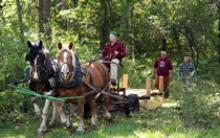You are here
Expanding Research on the Impacts of Deer and Moose

Four new pairs of deer and moose fence exclosures have been constructed in mature oak and hemlock stands at the Forest. These new undisturbed sites complement existing exclosures built in recently logged stands at Harvard Forest, on DCR Watershed Land, and in Northern CT. The study, led by Highstead ecologist Ed Faison and Steve DeStefano of the Mass. Cooperative Fish and Wildlife Unit, examines the effects of deer and moose (ungulate) browsing on tree regeneration, species diversity, and composition across a range of stand structures and compositions.
In addition, construction has just begun on exclosures for each of the treatments at the Simes Tract long-term Hemlock Removal Experiment. These exclosures will examine the effects of ungulate browsing on the understories of dying hemlock stands. In the early weeks of October, the Harvard Forest Woods Crew rented horses from a local farmer, Bruce Cheney. The horses were needed to move posts, fencing and other equipment into the research plots located deep in the forest—which trucks couldn't reach. Faison and DeStefano will collaborate with Aaron Ellison and Audrey Barker Plotkin on this project, which should provide valuable insights into the combined effects of mammalian and insect herbivory in temperate forest ecosystems.
Learn more about the moose and deer experiment and the long-term hemlock removal experiment.

